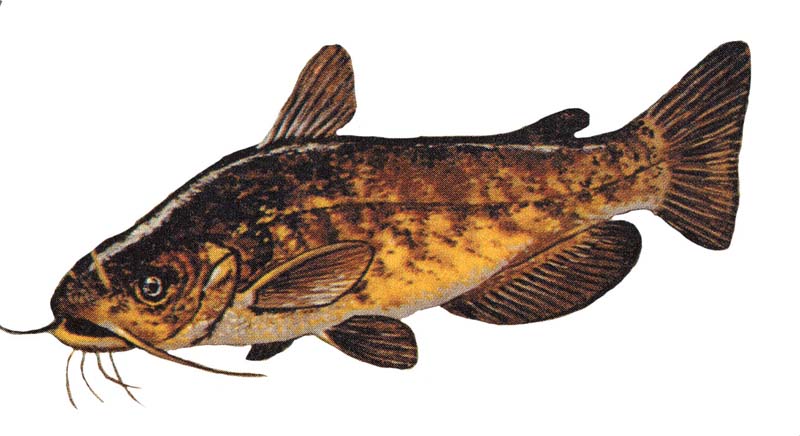|
| Query: chicken | Result: 686th of 694 | |
Bullhead Catfish (Family: Ictaluridae, Genus: Ameiurus) - Wiki
| Subject: | Bullhead Catfish (Family: Ictaluridae, Genus: Ameiurus) - Wiki
| |

| Resolution: 800x436
File Size: 77336 Bytes
Date: 2005:09:15 13:08:24
Upload Date: 2007:11:21 10:13:25
|
Bullhead catfish
From Wikipedia, the free encyclopedia
Scientific classification
Kingdom: Animalia
Phylum: Chordata
Class: Actinopterygii
Order: Siluriformes
Family: Ictaluridae
Genus: Ameiurus
Species
Ameiurus brunneus
Ameiurus catus
† Ameiurus hazenensis
† Ameiurus lavetti
† Ameiurus leidyi
† Ameiurus macgrewi
Ameiurus melas
Ameiurus natalis
Ameiurus nebulosus
† Ameiurus pectinatus
Ameiurus platycephalus
† Ameiurus reticulatus
† Ameiurus sawrockensis
Ameiurus serracanthus
† Ameiurus vespertinus
[Photo] Brown Bullhead (Ameiurus nebulosus). Source: from http://www.glerl.noaa.gov/pubs/photogallery/Fish/pages/1040.html
Bullhead catfish usually refers to the three common types of bullhead catfish found in waters of the United States, the black bullhead (Ameiurus melas), the brown bullhead (Ameiurus nebulosus), and the yellow bullhead (Ameiurus natalis), members of the genus Ameiurus. They can distiguished from channel catfish and blue catfish in that their tailfins are squared, rather than forked. Other fishes of the genus Ameiurus, such as the white catfish (Ameiurus catus) have a somewhat forked tail and are not typically called "bullheads", even though they share the same genus.
Taxonomy and fossil record
Ameiurus is recognized as monophyletic, meaning it forms a natural group. It is mostly closely related to the clade formed by Noturus, Prietella, Satan, and Pylodictis.
There are seven extant (living) species and eight fossil species of Ameiurus. The oldest, Ameiurus pectinatus, gives a minimum age estimate for the genus at approximately 30 million years, during the Oligocene.
There is a sister group relationship between the species A. melas and A. nebulosus.
Distribution
Living species of Ameiurus catfishes are natively distributed east of the North American continental divide, from their westernmost point in central Montana, south to Texas, in streams of the Gulf of Mexico and Atlantic Coast, north to New Brunswick and Quebec, Manitoba, and Saskatchewan.
Habitat
Bullheads live in a variety of habitats, including brackish and/or low oxygen ponds, rivers and lakes, although they are seldom stocked intentionally. They are bottom feeders and eat virtually anything edible, including dead fish, insects, other fish, grain, fruit, crayfish and more. Because of their limited use as food or sport, they are usually caught while trying to catch other fish, and few anglers pursue them specifically. Persons looking to catch bullheads will use the same baits as they would for channel catfish, including cut bait, chicken livers blood soaked meal, or other pungent baits. Like all catfish, bullheads have a sense of smell that is more developed than the best canine.
Description and identification
Bullheads do not get as large as the other US native catfishes, with averages sizes in the 1 to 2 pound range and world record sizes well under 10 pounds.
All three major bullheads can be confused with other catfishes by novice anglers. Because they have a non-forked tail, many people mistakenly think that small flathead catfish are bullheads. Both have the squared tail, and can have a mottled, brown appearance (in the case of the brown bullhead) but the flathead has a lower lip that protrudes farther than its upper lip and a flat or "shovel" head. They also have very different habits and habitat.
Flatheads generally eat only live things, while bullheads will freely eat dead fish or other small animals. The flathead is more likely to be found at the bottom of dams or in gravel pits, while bullheads are found more often in the most brackish areas. Additionally, flatheads can reach weights well in excess of 100 pounds, while the current world's record for any bullhead is a Black Bullhead, recorded at exactly 8 lb even, while the average adult is perhaps 2 pounds. Brown and yellow bullheads are significantly smaller.
Relationship to humans
They are considered rough fish by many, and are seldom caught for food, although they can be quite edible if caught in clear water and prepared correctly.
http://en.wikipedia.org/wiki/Bullhead_catfish
| The text in this page is based on the copyrighted Wikipedia article shown in above URL. It is used under the GNU Free Documentation License. You may redistribute it, verbatim or modified, providing that you comply with the terms of the GFDL. |
|
Comments |
|---|
| | cialis |
|
| sOvUBB xmqhiihz gjkgjcss uxsbnaba |
| | acquista cialis |
|
| vxpmrvlc tomlybpa ovtiwlnw |
| | cialis en pharmacie |
|
| wwzmdjvb hyxixltj idpstice |
| | acquista cialis |
|
| aymrltib lodvussr bsriqmvh |
| | levitra torrinomedica |
|
| nnjqpjxh xnzyoqrk uurgchmq |
^o^
Animal Pictures Archive for smart phones
^o^
|
|
|

